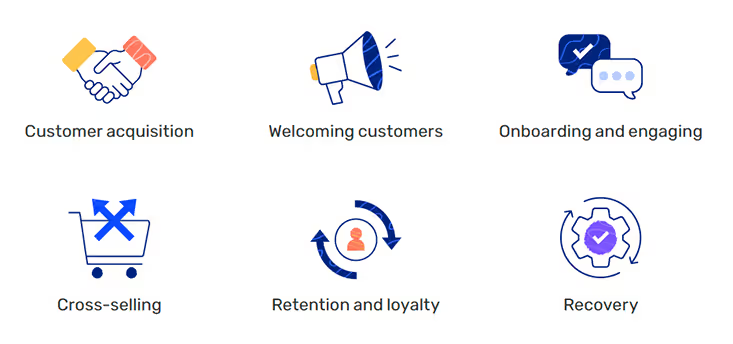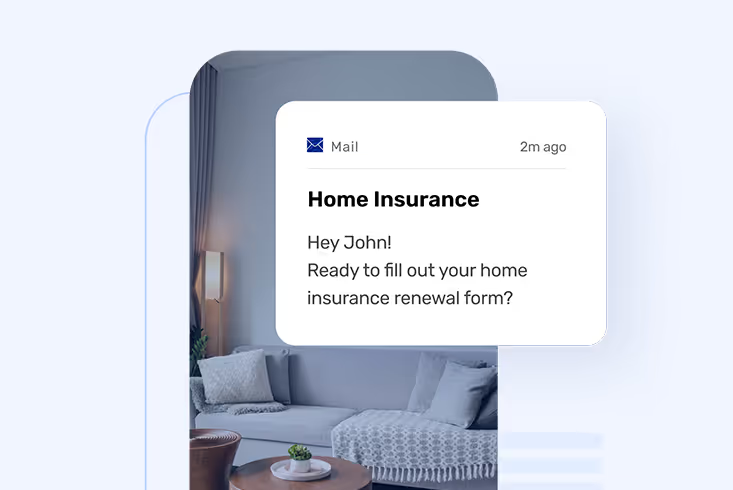In the early 2000s, something amazing happened that changed the world forever - the very first platform that enabled opening deposit accounts online was released.
Fast forward to 2024, and it is difficult to find a bank not already offering online or mobile checking accounts. The share of financial institutions offering digital account opening has reached 82% for online and 38% for mobile channels.
Today, customer onboarding has developed far beyond account openings. It is applied to virtually any service in the financial industry, from registering to an insurance plan, applying for a loan, opening a checking account, or getting a credit card.
While it’s good news that most financial institutions offer online account opening and at least some rudimentary cross-selling capabilities, digital applications in the financial sector are notoriously full of friction, and abandonment rates are high.
Simply having a digital capability might no longer be enough, as high abandonment and low engagement rates show.
Digital onboarding journey predictions for 2025 and beyond
Formative changes that are likely to happen in this space in 2025:
- An increased adoption of artificial intelligence (AI), chatbots, and virtual assistants will move front-line customer service online. The banking assistant of 2023 may be able to not only self-provision but also identify customers and provide personal guidance and recommendations.
- Transaction costs will decrease due to higher digital automation levels, as well as lower back-office staffing levels (AI will replace many routine manual processes).
- A growing number of different channels will make it necessary for banks to connect all points of contact with one system of record. The unified view will help with customer experience and decrease friction.
- Customer on-boarding levels will increase due to major changes in user interface (UI)/user experience (UX), as well as the change toward fully digital transactions. Customers' high expectations of speed, ease of use, and engaging experiences must be met for financial institutions to keep up with the demand.
- The increased focus of security and compliance will result in a lower tolerance for any form of errors, leading to process standardization across the board.
- Customer-centricity will rise due to a growing number of product offerings and new service channels. Financial institutions will need new ways to combine their products with competitive offers.
- Customer engagement will grow, but so will channel proliferation and fragmentation, requiring financial institutions to take a cross-channel approach to business strategies and technology architecture.
- Financial services entrepreneurs will emerge in emerging markets, leading to an increased rate of innovation with startups challenging incumbents' dominance. Incumbents will need to quickly implement innovation initiatives.
- Rapid growth of alternative financial services (e.g., peer-to-peer lending) will lead to the creation of new types of customer segments, requiring increased focus on risk management and compliance.
- Banks will be challenged by more competitors who are technologically agile and able to offer disruptive solutions. To stay relevant, banks need to improve their technology and product design capabilities.
- Customer data will become even more critical for financial institutions, allowing them to automatically personalize the customer experience. Machine-learning technologies will help with fraud detection and channel management, optimizing costs and achieving better customer engagement.
Prioritizing customer experience at every step of the journey
We can identify four distinct stages in the customer journey, and each builds on the other. To succeed in the digital world, we must treat the journey as a whole and deliver exceptional service at every stage of the journey:

[.emph]Financial institutions must remove friction and build exceptional experiences at all four stages to solidify and deepen customer relationships.[.emph]
Seamless application process
[.emph]Improve your digital customer journey: from onboarding to cross-selling[.emph]
1. Offer a multi-channel, continuous experience
Customers do not view interactions with your business in isolation. Every communication is a part of a continuous journey, not a collection of disconnected experiences. It is of crucial importance to deliver a top-notch brand experience, no matter the stage of the journey or the channel: your company website, a mobile app, email marketing, SMS, call-center, or in-person experience in your branch.
Educate new customers on what actions they need to take, and then guide them through a seamless journey that takes them through the entire process step by step.
2. A fast and seamless application process is a must
[.emph]70% to 90% of applicants who clicked ‘apply now’ will abandon the process before their applications are completed.[.emph]
The biggest reason for high abandonment rates? The lengthy application processes. If you think potential customers will invest more than ten minutes to opening an account online, think again.
According to DBR, online applications that take ten minutes or longer to complete negatively affect account openings by as much as 40%. This means that if your application process has yielded 6,000 customers, it might have opened 10,000 if friction wasn’t an issue.
Cut down your process to the bare minimum you require to get the customer started on the journey, and don’t overwhelm them early on with lengthy applications.
3. Eliminate extra steps
Too often, institutions simply provide a PDF form and ask customers to complete it and then send it via email or attachment back to them. This may have been fine 20 years ago, but in 2025 this will no longer work.
Financial institutions must eliminate PDF forms and invest in technology that enables people to switch complete the application process without interruptions, such as digital journeys with eSignatures that allow the customer to complete the entire process digitally in one sitting.
Frictionless oboarding process
4. Assist your customers and help them use your service
Technology is all well and good, but you can’t leave the less technology-oriented customers behind. One example would be the rapid deployment of telehealth during the COVID-19 pandemic. As healthcare providers were scrambling to make those platforms available, they often failed to reach the people they’re supposed to reach.
Starting with surveys and screenings, it is crucial to identify who would benefit from using your digital service and determine how much help they’d need adapting to the technology.
For example, giving patients a quick refresher on how to use that app or device as a part of the digital experience could go a long way toward improved and continued engagement and, in the long run, better outcomes.

5. Balance self-service and support
Self-service portals are an excellent way to serve and onboard the modern customer; however, if the support is not readily available in a single click, the customer can quickly get frustrated and abandon the virtual onboarding experience altogether.
It is crucial to integrate support workflows into any type of digital customer journey so that the customer can have their questions answered in real-time instead of abandoning the application altogether.
6. Personalize experiences
Customers are well aware that digital channels collect a lot of personal information about them, including behavioral data, their location, and any information they have may affect input on any of your forms. They expect a business to use this information to improve and personalize their experience.
To do that, you must ensure not simply to hoard data but to use it wisely.
One way to leverage the data you have is to personalize your messages. Basic online pop-up messages, emails, and SMS messages are not enough. Personalize your messages and point your customers towards relevant step-by-step guides and tools that make onboarding tasks easier.
Engaging with your customers
7. Retarget abandoned applications
Re-engaging a consumer who already expressed initial interest is much easier than attracting someone new. That is why retargeting abandoned applicants who left your journey without completing it pays enormous dividends.
Capture and save applicants’ email addresses or mobile numbers as quickly as possible in your digital journey. If you do that, you can follow up with email and SMS reminders that motivate abandoned applicants to come back and complete the onboarding process.

8. Guide new customers
[.emph]If a new account opener doesn’t start using their account in the first 90 days, they probably never will.[.emph]
It is not enough simply to onboard the customer; the customer must be reminded to start using their account immediately. Communicate with your customer early and often, offering tools and tips to make things easier.
After the application journey, make sure to enroll new customers in a well thought through, personalized onboarding experience that will guide them through the entire process, that will guide them through the following actions they need to take, such as:
- Switching direct deposits
- Activating the new debit card
- Updating automatic payments
- Learning about a rewards program
Boosting cross-sell capabilities
9. Deliver personalized offers
Banks and credit unions often miss cross-selling opportunities by not delivering proactive and personalized offers. One-third of banking customers report going to competing institutions for additional services.
It is crucial to continuously educate customers and members on what you offer.

10. Use data to anticipate the needs
While you can frequently ask customers about their needs, it’s more effective if you can identify when a new need arises.
Leverage behavioral data you collect and third-party data to identify when customers begin shopping around for a financially related need.
Retaining customers
11. Smart use of analytics to reduce churn
Turn a one-time purchase into a long-term relationship with the customer by using smart analytics to detect early behaviors that may indicate a higher risk of leaving. You can keep in touch with your customers when they leave and offer incentives to bring them back.

12. Frequent contact
In a perfect world, banks and credit unions could contact customers daily—but that is not always possible. In our fast-paced world, most customers find it annoying if they are contacted too often. However, they still expect you to keep in touch with them after the onboarding experience is complete.
The key is to use behavioral data, previous contact history, and third-party data providers to determine the best frequency for your direct interactions with customers before they leave.
13. Respond to customer feedback
Listen first; respond second
Listening comes first; responding comes second—or at least it should. Listening allows you to understand your customers and create personalized experiences. Responding means acting on that feedback in a timely manner. Your customer expects you to use the data they provide when asking for feedback.
Unfortunately, many banks and credit unions do not act upon their customers’ comments; instead, they send an automated response thanking the customer for contacting them. Use the opportunity to collect valuable customer feedback and take action.
14. Re-engage customers who have left
Customer recovery is a critical element of customer retention, as those who leave are often those whose needs aren’t being met.
[.emph]The median annual attrition rate is 14%—which means that for every 100 customers you acquire, 14 will voluntarily leave you.[.emph]
Customer recovery is about more than just sending an email or making a phone call to customers who have left—it’s also about creating an exclusive re-engagement campaigns. This will help increase the likelihood that your customer wants to rejoin your community and change their negative perception of you, which will in turn increase their likelihood of recommending you to others.
It is clear that offering personalized experiences will help banks and credit unions retain customers, which is good for business.
Create end-to-end digital journeys: from onboarding to cross-selling
It’s important to remember that the first five minutes of a customer’s account opening experience can be as influential as the first 50 years.
The goal is to focus on the behaviors, needs and risk factors associated with each stage of an account opening, so you can deliver a personalized experience every time—a "best in class" experience that inspires customer loyalty for life.
Deeper relationships with customers throughout the entire digital customer journey from application to cross-selling require a platform that supports engaging, personalized journeys at every step of the way.
15. Use a no-code platform to transform digital onboarding
Typically, banks use several different technologies for this purpose, with no clear cross-channel user experience. Using multiple tools that lack integration is time-consuming and expensive; therefore, they often fail to meet customer expectations or deliver the results you want.
By using a digital customer journey platform that offers end-to-end management of your entire onboard ing and cross-selling process, you can create personalized journeys that support your customer engagement strategy.
EasySend is a no-code platform that empowers financial institutions to craft and launch digital journeys quickly and efficiently, at every stage of the journey. From a frictionless application process that enables customers to complete the application without leaving the app, to instant welcomes for new customers and members, to frictionless adoption of account-related services and consistent, personalized communication, EasySend has got you covered.
.avif)



.avif)
.avif)


.avif)
